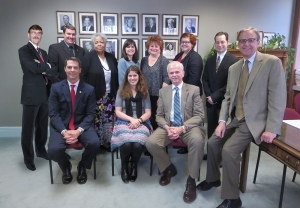Concluding a 25-year career with the U.S. Secret Service, most lately as special agent in charge of the Pittsburgh field office, Eric. P. Zahren was elected the Commission’s new Executive Director (see related article) May 23, 2016. Here are his thoughts.
imPULSE: What attracted you to the Hero Fund? How did you first learn of it?
Mr. Zahren: It was at least 10 years ago that I first read of the Hero Fund in a Carnegie biography, and not more than a couple of weeks later, I saw a newspaper report on the latest Carnegie Medal awardees. I was immediately struck by the strength and simplicity of the Hero Fund’s mission and by Carnegie’s very personal convictions to recognize and support civilian heroism, a great idea that was strictly his own. And the Pittsburgh connection didn’t hurt for a fairly well-traveled native Pittsburgher with more than a little hometown pride!
You said you “followed my heart” in pursuing an association with the Commission. What was your heart telling you?
A career with the Secret Service is a unique and multi-faceted experience, one that I feel prepared me to go in any number of directions when it came to an end. In considering future pursuits, I couldn’t shake the powerful gravitational force of the “inspirational path” represented by the Hero Fund and what it stands for, the presence of true altruism in our society in the persons of heroes through their truly selfless acts. This impulse was far stronger, and carried far greater weight, than any other path that I could have considered. Also, having had the experience of collaborating with organizations such as the Make-a-Wish Foundation, Special Olympics, and the Boys and Girls Clubs, I felt profound satisfaction at giving back and making a difference for others, and it stuck as a general future objective.
What parts of your training and experience might dovetail with the Hero Fund’s work?
I have spent the past 25 years fundamentally as an investigator, and that is at the core of the Commission’s work. The thorough manner in which the Hero Fund has investigated cases of heroism through the years is what sets it apart and establishes the unparalleled integrity of the work and the Carnegie Medal itself. In addition, I am fortunate to have served in diverse roles throughout my career, overseeing areas ranging from personnel and budget management to strategic planning and media and public affairs. These all align with the Commission’s work. But more so, dealing openly and effectively with all types of people has led to past successes and I trust will serve me in moving forward.
Is naming heroes a quaint, or perhaps an outdated, concept? What is the purpose of it?
Heroism is a timeless concept. This aspect of timelessness is one of the most important and compelling inherent characteristics of the Hero Fund, one worthy of our full devotion and protection. Heroism never fades, and the world needs it now as much as ever. How uplifting is that it can still be found, and in such remarkable quantities. It is a most important work to recognize that fact and carry it forward.
Given that Mr. Carnegie’s Deed of Trust, outlining our goals, was written in 1904, what 21st century realities might shape your oversight of the Hero Fund’s work?
The Hero Fund has done a tremendous job of maintaining its identity and the foundation of its practices while at the same time incorporating the right amount of modern touches. Technology, and specifically modern communication channels such as social media, is now being utilized to carry Carnegie’s vision forward in a useful and efficient way. This is both consistent with and complementary of Carnegie’s mandate, while still maintaining its spirit and classic form in terms of case investigation and the many meaningful personal touches that set it apart.
Popular culture applies the term “hero” broadly, whereas the Commission’s definition is much narrower, limited to those who risk their lives saving others. That said, who were—or are—your “heroes” or role models?
I have always been deeply impacted by those who place others before themselves. This applies to heroes in both the general sense and surely in terms of the Hero Fund’s more limited definition. The words of John 15:13, “Greater love hath no man than this, than a man lay down his life for his friends,” embossed on every Carnegie Medal, are now and always have been for me very powerful. I have been fortunate to have had a front-row seat and a 360-degree view of heroism through the years, and it has had a deep and lasting impact on who I am today. I have witnessed tremendous courage and selflessness on the parts of others. In 2009, when my brother-in-law, Pittsburgh Police Officer Paul Sciullo, along with officers Stephen Mayhle and Eric Kelly, were killed in the line of duty, I experienced firsthand both the intense pain and the profound pride of a loved one’s sacrifice as well as the more unexpected and almost inexplicable hope generated by the recognition and support of others. These experiences have served to intensify my conviction to honor the true heroes of civilization, those who risk all for the love of others, even strangers.

Return to imPULSE index.
See PDF of this issue.

